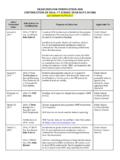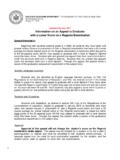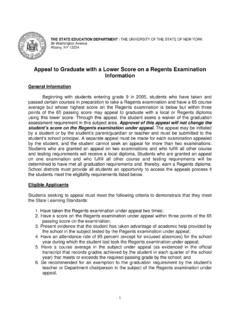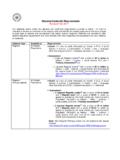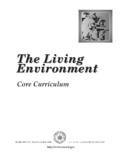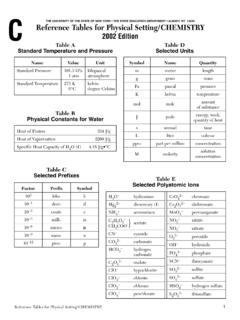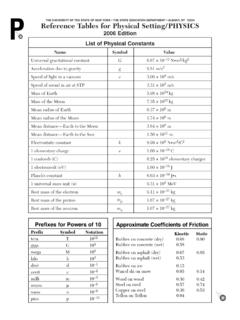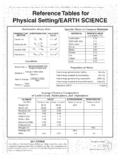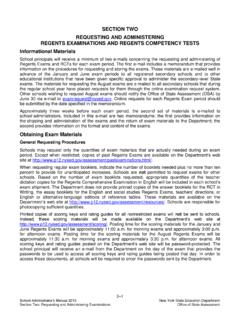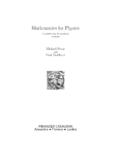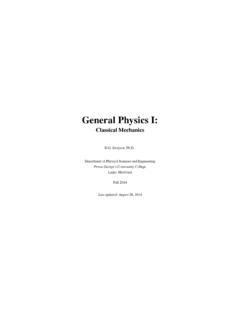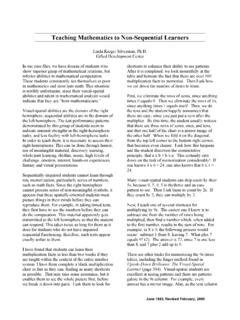Transcription of Physical Setting/Physics Core Curriculum
1 Physical Setting/. physics Core Curriculum THE UNIVERSITY OF THE STATE OF NEW YORK THE STATE EDUCATION DEPARTMENT. THE UNIVERSITY O F THE STATE O F NEW YORK. Regents of The University CARL T. HAYDEN, Chancellor, , ..Elmira ADELAIDE L. SANFORD, Vice Chancellor, , , ..Hollis DIANE O'NEILL MCGIVERN, , , ..Staten Island SAUL B. COHEN, , , ..New Rochelle JAMES C. DAWSON, , , , ..Peru ROBERT M. BENNETT, , ..Tonawanda ROBERT M. JOHNSON, , ..Huntington ANTHONY S. BOTTAR, , ..North Syracuse MERRYL H. TISCH, , ..New York ENA L. FARLEY, , , ..Brockport GERALDINE D. CHAPEY, , , Harbor ARNOLD B. GARDNER, , CHARLOTTE K. FRANK, , , ..New York HARRY PHILLIPS, 3rd, , ..Hartsdale JOSEPH E. BOWMAN, JR., , , , , ..Albany LORRAINE A. CORT S-V ZQUEZ, , President of The University and Commissioner of Education RICHARD P. MILLS. Chief Operating Officer RICHARD H. CATE. Deputy Commissioner for Elementary, Middle, Secondary, and Continuing Education JAMES A.
2 KADAMUS. Assistant Commissioner for Curriculum , Instruction, and Assessment ROSEANNE DEFABIO. Assistant Director for Curriculum and Instruction ANNE SCHIANO. The State Education Department does not discriminate on the basis of age, color, religion, creed, dis . ability, marital status, veteran status, national origin, race, gender, genetic predisposition or carrier sta . tus, or sexual orientation in its educational programs, services, and activities. Portions of this publica . tion can be made available in a variety of formats, including braille, large print or audio tape, upon request. Inquiries concerning this policy of nondiscrimination should be directed to the Department's Office for Diversity, Ethics, and Access, Room 152, Education Building, Albany, NY 12234. CONTENTS. Acknowledgments ..vi Core Curriculum ..1. Preface ..3. Process Skills Based on Standards 1, 2, 6, and 7 ..6. Process Skills Based on Standard 4.
3 13. Standard 4: The Physical Setting ..14. Appendices ..19. physics iii ACKNOWLEDGMENTS. The State Education Department acknowledges the assistance of teachers and school administrators from across New York State and the physics Mentor Network. In particular, the State Education Department would like to thank: Joseph M. Akramoff Columbia High School, East Greenbush George Amann F. D. Roosevelt High School, Hyde Park Angela Cigna-Lukaszewski Syosset High School, Syosset/Hofstra University Bernadine Hladik Cook Johnstown High School, Johnstown Michael Herzog Hilton Central School, Hilton Elizabeth Hokanson Niskayuna High School, Niskayuna Dennis Hulbert Plattsburgh High School, Plattsburgh Jim Iak Rush Henrietta High School, Henrietta Michael Jabot Oneida High School, Oneida Reuben James SUNY Oneonta, Oneonta Randy Jenkins Scotia-Glenville Schools, Scotia Terese Keogh Manhasset High School, Manhasset Robert Kruckeberg Phillip Randolph High School, New York William Leacock W.
4 C. Mepham High School, Bellmore Edmond Nurse High School of Transit Technology, Brooklyn Carl Preske G. Ray Bodley High School, Fulton Theodore Reiss Monroe-Woodbury High School, Central Valley Charlene Rydgren Franklin Academy High School, Malone Valerie J. Suter Arlington High School, LaGrangeville Andrew Telesca, Jr. Johnson City High School, Johnson City/Binghamton University Virginia Trombley Au Sable Valley High School, Clintonville Butch Weir Oneonta High School, Oneonta Joseph Zawicki Elba Central School, Elba The Physical Setting/Physics Core Curriculum was reviewed by many teachers and administrators across the State. The State Education Department thanks those individuals who provided feedback both formally and informally. The project manager for the development of the Physical Setting/Physics Core Curriculum was Diana K. Harding, Associate in Science Education, with content and assessment support provided by Mary Oliver, Associate in Educational Testing.
5 Elise Russo, Associate in Science Education, provided additional support. Special thanks go to Jan Christman for technical expertise and to Joe Zawicki for preliminary drafts of the document. iv physics Physical Setting/. physics Core Curriculum 2 physics PREFACE. This Physical Setting/Physics Core Curriculum is intended to be a catalyst for significant change in the teaching of high school physics . The primary focus of the classroom experience should be on the development of higher order process skills. The content becomes the context and the vehicle for the teaching of these skills rather than an end in itself. This Physical Setting/Physics Core Curriculum has been ately been built into the year to permit students to written to assist teachers and supervisors as they pre examine these topics in greater depth or investigate pare Curriculum , instruction, and assessment for the new areas of physics . This time facilitates the inclusion physics content and process skills of the New York of experiences supporting analysis, inquiry, intercon.
6 State Learning Standards for Mathematics, Science, and nectedness, and problem solving. The focus on concep . Technology. This core Curriculum , including the skills tual understanding in the guide is consistent with the section, should be seen as part of a continuum that approaches recommended in the National Science elaborates the science content of Standard 4. The Education Standards and Benchmarks of Science Literacy: Learning Standards for Mathematics, Science, and Project 2061. Technology identifies key ideas and performance indica . tors. This document should serve as the basis for local Misconceptions greatly influence learning. Students Curriculum development by providing insight for the may internalize new ideas, but if the learning is incor . interpretation and implementation of the core under porated into incorrect assumptions or ideas, the learn . standings. Key ideas are broad, unifying, general state ing is superficial and of doubtful value.
7 Educational ments of what students need to know. The performance research has shown that students typically learn best by indicators for each key idea are statements of what stu moving from the concrete to the abstract; learning is dents should be able to do to provide evidence that enhanced through the use of manipulatives and hands- they understand the key idea. As part of this contin on activities. Teachers can dramatically influence learn . uum, this core Curriculum presents major understand ing by providing constructive feedback and by ings and skills that give specific detail to the concepts maintaining appropriately rigorous expectations. underlying each performance indicator. Science for All Americans: Project 2061 makes several rec . This core Curriculum guide is not a syllabus. It ommendations that foster effective science teaching. addresses the content and process skills as applied to The use of inquiry is central to scientific thought and the rigor and relevancy to be assessed by the in the therefore an extremely powerful teaching tool in the Physical Setting/Physics Regents Examination.
8 The physics classroom. Real-world questions to focus the focus of the examination is the application of skills to attention of the student, active student involvement, real-world situations. The core Curriculum has been and the collection and use of evidence are essential prepared with the assumption that the content as out components of effective science teaching. Since science lined in the Learning Standards for Mathematics, Science, is a collaborative process, the use of teams (cooperative and Technology at the elementary and intermediate lev learning groups) is encouraged. It is important to els has been taught previously. This is a guide for the encourage curiosity and to support academic growth, preparation of commencement-level Curriculum , especially for female and minority students who have instruction, and assessment, the final stage in a K 12 been underrepresented in physics . continuum of science education.
9 Teachers should recog . nize that what is found in this document (including the It is essential that instruction focus on student under . core content and skills sections) is the minimum content standings, mathematical relationships, processes, to be assessed. Teachers are expected to provide for mechanisms, and the application of concepts. Students, horizontal and vertical enrichment. This core curricu in attaining scientific literacy, will be able to provide lum has specifically been constructed to permit the explanations in their own words, exhibiting creative exploration of the richness of physics . Time has deliber problem solving, reasoning, and informed decision physics 3. making. Future assessments will access students' concurrently with Leibniz, developed calculus as a tool ability to explain, analyze, and interpret physics for the solution of problems within physics . processes and phenomena and generate science inquiry.
10 The general nature of the statements in this Subatomic Investigations guide will encourage the teaching of science under On a microscopic level, a relationship between electric . standing instead of emphasizing the memorization of ity and magnetism was demonstrated by the induction facts. The major understandings in this guide permit of voltage in a conductor passing through a magnetic teachers a large degree of flexibility, making rich and field. Electrolysis was explored; studies established a creative instruction possible, and allowing for proportionality between current and the mass of a sub . multifaceted assessment. stance generated at an electrode. Radium was discov . ered; the existence of three types of radiation alpha, The order of presentation and numbering of all state beta, and gamma rays was demonstrated. Evidence ments in this guide are not meant to indicate any for both a wave nature and a quantum nature of light recommended sequence of instruction.

